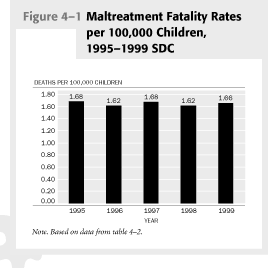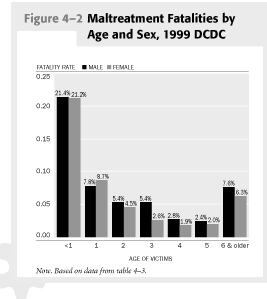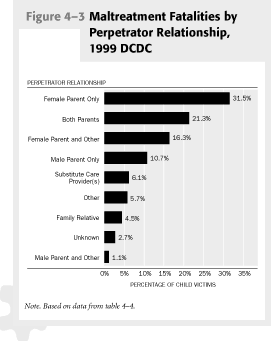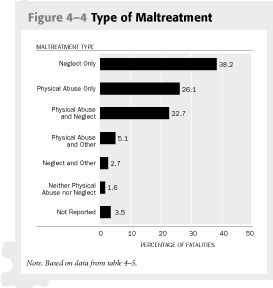CHAPTER 4 FATALITIES
Child fatalities are the most tragic consequence of maltreatment. In this chapter, national estimates of the number and rate of child maltreatment fatalities per 100,000 children are provided, based on data submitted to the SDC. These estimates are followed by a discussion of the characteristics of maltreatment fatality victims, including age, sex, type of contributing maltreatment, and relationship of the victim to the perpetrator, based on case-level data from the DCDC.
4.1 NUMBER OF CHILD FATALITIES
In 1999, 1.6 children of every 100,000 children in the population died from abuse or neglect. This rate yields a national estimate of 1,100 child deaths from abuse and neglect. Twenty-two fatalities or approximately 2.1 percent, occurred while the children were in foster care. (See table 4-1.)
As illustrated in figure 4-1, data from the past 5 years indicate that the maltreatment fatality rate has remained fairly stable. Between 1995 and 1999, the annual rate fluctuated between 1.62 and 1.68.
4.2 FATALITY VICTIMS BY AGE AND SEX (DCDC)
Fatality victims were typically very young. Moreover, the risk of a child being a fatality victim declined consistently with age until the child reached age 8. Children younger than a year old accounted for 42.6 percent of the fatalities, and 86.1 percent were younger than 6 years of age. Male children and female children accounted for almost equal percentages of victims in each age group.
4.3 FATALITY PERPETRATORS (DCDC)
As illustrated in figure 4-3, most maltreatment fatality victims, 80.9 percent, were maltreated by one or more of their parents (in comparison, as described in chapter 3, 87.3% of all victims were maltreated by one or more of their parents). These percentages are consistent with findings reported in previous years.
The most striking difference between maltreatment fatalities and other types of maltreatment is that maltreatment fatalities were less frequently perpetrated by just one parent acting alone. Only 42.2 percent of child fatalities were attributed to either the male or female parent acting alone (in comparison, 60.6% of all victims were maltreated by either the male or female parent acting alone).
4.4 FATALITIES BY TYPE OF MALTREATMENT (DCDC)
As indicated in figure 4-4, maltreatment deaths were more often associated with neglect (38.2%) than with any other type of abuse. Physical abuse was identified as the contributing factor in more than a quarter of the reported deaths (26.1%). A combination of physical abuse and neglect was associated with another 22.7 percent of fatalities.
4.5 FATALITIES BY PRIOR CONTACT WITH CPS
Slightly more than one-tenth (12.5%) of the families of child fatalities received family preservation services in the 5 years prior to the deaths. Only 2.7 percent of the child fatality victims were returned to the care of their families prior to their deaths. (See table 4-6.)



